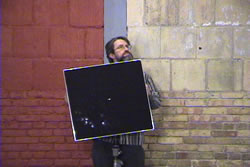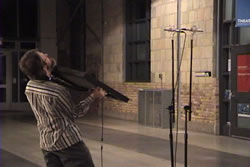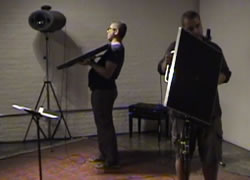The Audio Spotlight in Electroacoustic Performance Spatialization
At the Toronto Electroacoustic Symposium in 2011, I demonstrated my research up to that date with the Holosonic Audio Spotlight directional loudspeaker. The following article, prepared for this issue of eContact!, provides a summary of my research with the Audio Spotlight up to the present date.
Background
The Audio Spotlight, manufactured by Holosonics in Watertown, Massachusetts, is a directional loudspeaker designed by F. Joseph Pompei. Directional loudspeakers have emerged on the loudspeaker market in order to address situations where audio content must be zoned to very small confined areas and prevented from bleeding over to other areas where the content is not intended to be heard. This requirement is common in museum exhibits and trade show conventions where sounds from adjacent exhibits often overlap with each other, and when perceived on a macro view of the resulting soundscape of the museum or exhibit hall, makes for an unpleasantly chaotic acoustic environment.

There have been a number of directional loudspeaker products which disperse sound waves in a 15 (or less) degree of dispersion rather than the more typical 90 (or more) degrees. Some models like the Panphonics Sound Shower use electrostatic technology. Others use speakers mounted in parabolic domes. The Audio Spotlight has a different approach. It emits sound waves in the ultrasonic range that, upon interacting with the atmosphere, produce sound waves which are audible to humans. Since the physical length of the ultrasonic waveforms is smaller than the 24" x 24" size of the Audio Spotlight’s flat panel, the sound waves are beamed in a very pinpoint five-degree area. 1[1. The Audio Spotlight in particular was expensive to purchase, but when compared to the labour cost of mounting loudspeakers for every performance, or facing the reality of not having any elevated loudspeakers at all, I felt it was a worthwhile investment. There were cheaper options for directional speakers, but I chose the Holosonic Audio Spotlights (after comparing them to competitor models) for their unique characteristics which I thought would stand out more from sounds coming from conventional loudspeakers. I also was interested in meeting the particular challenges they presented to spatialization performance practice.]
The sound waves from these loudspeakers also have a fair amount of intensity and can bounce off of hard, flat surfaces quite noticeably. In fact, when using the spotlights on their own or in some featured way, I have found that venues like galleries, atriums and other places which are generally not suitable for loudspeaker spatialization are often more desirable and effective for the Audio Spotlight. Another interesting feature is that the waves can be projected over long distances without much loss in intensity compared to conventional speakers. I have used them quite effectively in large fields or other open areas where the waves have travelled 200 feet and still could be detected by listeners. This is a feature that certainly deserves more investigation in the context of site-specific installations and performances, and in particular, public art works.
Finally, the Audio Spotlights are light enough that they can be handled by a performer. My colleague Chris Clifford designed two methods for a performer to hold the Audio Spotlight and manipulate it in performance. One option places the spotlight in a metal frame with handles on the sides and a mounting point at the bottom that allows the speaker to be rotated 360 degrees on a tripod stand (Fig. 1 and Video 1). The other option has a wood frame with handles on the side which are connected with a strap that goes around the performer’s neck like the strap for an accordion player (Fig. 2 and Video 1). This option allows more freedom of movement but it has the disadvantage of being physically more demanding for the performer, who must support most of the weight.
In workshops to present the Spotlight as a performance tool thus far, I have explored positioning two performers in three different ways:
- 2 performers on the stage in front of the audience;
- 1 performer to the left and another to the right of the audience mid-way along the sides of the seating area;
- 1 performer in front and another behind the audience.
The first method is the only one I have used in performance thus far, so it is difficult to make a conclusive statement on which placement works best. I also have not had the chance yet to place performers at different elevations, which might also be quite effective.
Performance Objectives
With funding from the Chalmers Family Fellowship (administered by the Ontario Arts Council) and from the Media Arts Section of the Canada Council for the Arts in 2011, I researched and developed new strategies for diffusing electroacoustic music in performances that operate on a small production budget as well as in venues where the suspension of loudspeakers from the ceiling or other higher elevations was not a viable option. Another objective of my research was to adapt the physical actions necessary for spatialization (or diffusion for those that prefer that term) so that from the audience’s perspective there would be a higher degree of correlation between physical action and sound localization. I had already introduced the use of the Polhemus Patriot sensor as a means for gestural control of spatialization, but I wanted to expand that more and add additional spatialization performers to make spatialization an ensemble performance, which to my knowledge is unprecedented in electroacoustic music and sound art.

The Audio Spotlight met both of these objectives in the following ways:
a) No speakers mounted in the ceiling.
The Audio Spotlight’s intensely narrow high frequency beam addressed my first objective of positioning sounds in high locations by having a performer on stage bounce sounds off of surfaces such as walls and ceilings, giving the impression that the sounds were coming from speakers located in those places. Also, the fact that these sounds were being moved manually by moving the speaker provided a certain fluidity and life-like quality of perceptible movement that required no computer programming or other forms of simulation. The sense of movement was coming from a source which was actually moving in space.
b) Improved performer-localization correlation.
My second objective was met by expanding the performance of spatialization to being an ensemble performance with the two Audio Spotlight performers added to the already established spatialization performer using the Patriot gestural controller. 2[2. The six degrees of freedom of the Patriot are mapped to all control parameters of the spit~ spatialization software patch running in Max/MSP, which is designed by Benjamin Thigpen.] As well, the movement of the Audio Spotlight performer corresponds to the resulting sound movement. The only problematic aspect with this correlation is the fact that sounds may occur from unexpected locations in spaces like galleries, which have a lot of reflective flat surfaces. In those instances, sounds may bounce multiple times and therefore be localized by some audience members to be occurring in a location that is contradictory to what the visible movements of the performer may suggest. However, there is a correlation that is at least perceptively consistent with the performer’s intention. This I feel is an improvement over mixing console-based spatialization practices, where the movement of the performer’s hands is not visible at all to ninety-five percent of the audience in most venues. 3[3. Some electroacoustic composers and sound artists would argue that the movement of performers is a distraction for listening in an acousmatic context. The movement of performers though has been a useful guide to music listening for centuries and if it ever poses a problem for listeners, then there is always the option to close one’s eyes, or to look elsewhere.]


Limitations
The major drawback is that the Audio Spotlight is basically a tweeter. From my experience, it does not produce usable content below 800 Hz. Fortunately, the sensitivity to localization is much greater in the presence band (1 to 5 kHz), and the fidelity of the Audio Spotlight in that range is acceptable. In a solo performance using just Audio Spotlights, this limited bandwidth is not a problem. In terms of spatialization, a solo Audio Spotlight performance would be like attending a flute recital. However, not unlike the orchestration challenges of incorporating a solo part for a flute in an orchestral work, the Audio Spotlights also requires specific orchestration strategies when incorporating them into systems with full-range loudspeaker systems. One rather extreme strategy is to diminish the amplitude of presence band frequencies in the full-range loudspeakers. However, more interesting solutions can arise when artists begin composing pieces with the Audio Spotlights in mind and assign content appropriate for their unique characteristics.
I have discovered that when used in the context of a soundwalk performance, the Audio Spotlight’s characteristics make it a distinctive solo voice in the soundscape which can be followed by the soundwalk listeners, while at the same time, their dispersion in the acoustic environment has a minimal impact compared to conventional loudspeakers. The results of using them in soundwalk performances has been so intriguing that I have incorporated a portable battery system, which allows the Audio Spotlight performer to be as mobile as the soundwalk audience. 4[4. The battery system was introduced at the TransX artist residency at NAISA in May 2011 when artist Amos Letteier created a mobile performance, where he projected his speaking voice using the Audio Spotlight into the park soundscape outside of the Artscape Wychwood Barns.] But in the context of using them with full range speakers, their distinctive way of projecting these narrow beams of sound waves (which are moved around the space through the physical gestures of the performer) has a distinctive enough quality to stand out from the sounds coming from other speakers.
Another distinctive feature is the directional characteristic of the Audio Spotlight. In a full-range system with the amplitude levels of all of the loudspeakers equally balanced, a sound which is coming from a single loudspeaker would radiate in such a way that it would be perceived by everyone in the audience as emitting from the physical location of that speaker. 5[5. Of course, once a sound is reproduced on more than one loudspeaker, localization of a sound becomes more ambiguous due to the Precedence Effect.]
The Audio Spotlights poses a different set of problems. When they are directed at a specific point in the space, there is the likelihood that not everyone in the audience will perceive the sound. This is particularly the case when they are pointed at something which absorbs sounds, like fabric or clothing. This is problematic for the current paradigm of loudspeaker spatialization, where all speakers are typically heard by everyone in the audience. Yet it is interesting to ponder the idea of different content being heard by different audience members. However in the current paradigm, this limitation can be addressed by carefully working in the hall to explore which positions can be perceived by all audience members. This can be aided in venues that have few reflective surfaces by mounting flat surfaces like sheets of Plexiglas, for instance, in specific locales or simply by removing the velour curtains that the ears of electroacoustic artists have grown to appreciate and depend on.
Conclusion
There are still many more challenges that need to be addressed and sorted out as I continue using the Audio Spotlights. The process of using them is still quite new for me. However, the Audio Spotlights have such distinctive characteristics that downplaying their defining features in favour of using them as if they are conventional loudspeakers — which they are definitely not — would close the door to many possibilities.
I am eager to use the Audio Spotlights for outdoor and indoor performances and installations, and interested in hearing pieces that explore different content for different listeners, not just different spatial zones. And most of all, as an audience member, I am intrigued by watching someone gracefully moving these flat panels around and hearing sounds bounce around the space as a result. In using them I may not get the results I intended, but now that I have begun to use them, I can not help but want to explore more.
As one final point to consider, it is feasible with the Audio Spotlight to tour electroacoustic and sound art works to galleries and small venues which, because of their traditionally flat parallel surfaces, have been acoustically undesirable locations for electroacoustic music and sound art — not to mention the lack of access they often have to good quality audio equipment. However, those issues are not a problem with the Audio Spotlight and it is affordable to tour with them — perhaps supported by a small 5.1 system — and have the chance to reach audiences in cities and towns that normally do not have access to electroacoustic music and sound art. From my home in the Greater Toronto area, there are a lot of possible venues previously unusable that are just within a five-hour drive — not to mention those existing across longer distances.
Bibliography
Audio Spotlight brochure. “Audio Spotlight: directional sound system.” Holosonics, Inc. http://www.holosonics.com
Social top